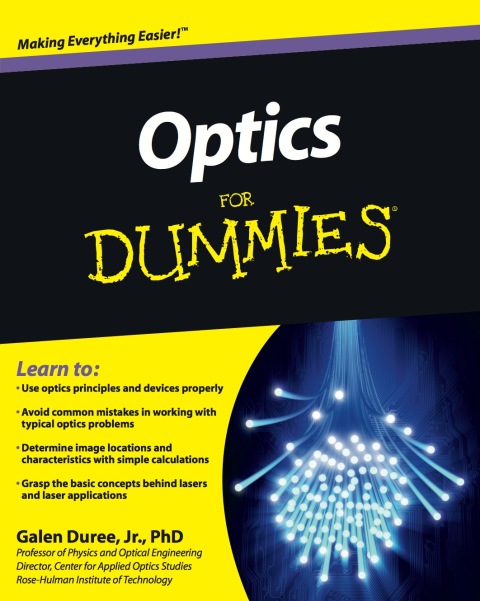Description
Efnisyfirlit
- Contents at a Glance
- Table of Contents
- Introduction
- About This Book
- Conventions Used in This Book
- What You’re Not to Read
- Foolish Assumptions
- How This Book Is Organized
- Icons Used in This Book
- Where to Go from Here
- Part I: Getting Up to Speed on Optics Fundamentals
- Chapter 1: Introducing Optics, the Science of Light
- Illuminating the Properties of Light
- Using Optics to Your Advantage: Basic Applications
- Expanding Your Understanding of Optics
- Paving the Way: Contributions to Optics
- Chapter 2: Brushing Up on Optics-Related Math and Physics
- Working with Physical Measurements
- Refreshing Your Mathematics Memory
- Reviewing Wave Physics
- Chapter 3: A Little Light Study: Reviewing Light Basics
- Developing Early Ideas about the Nature of Light
- Taking a Closer Look at Light Waves
- Einstein’s Revolutionary Idea about Light: Quanta
- Let There Be Light: Understanding the Three Processes that Produce Light
- Introducing the Three Fields of Study within Optics
- Chapter 4: Understanding How to Direct Where Light Goes
- Reflection: Bouncing Light Off Surfaces
- Refraction: Bending Light as It Goes Through a Surface
- Diffraction: Bending Light around an Obstacle
- Part II: Geometrical Optics: Working with More Than One Ray
- Chapter 5: Forming Images with Multiple Rays of Light
- The Simplest Method: Using Shadows to Create Images
- Forming Images Without a Lens: The Pinhole Camera Principle
- Eyeing Basic Image Characteristics for Optical System Design
- Zeroing In on the Focal Point and Focal Length
- Chapter 6: Imaging with Mirrors: Bouncing Many Rays Around
- Keeping it Simple with Flat Mirrors
- Changing Shape with Concave and Convex Mirrors
- Chapter 7: Imaging with Refraction: Bending Many Rays at the Same Time
- Locating the Image Produced by a Refracting Surface
- Looking at Lenses: Two Refracting Surfaces Stuck Close Together
- Part III: Physical Optics: Using the Light Wave
- Chapter 8: Optical Polarization: Describing the Wiggling Electric Field in Light
- Describing Optical Polarization
- Examining the Different Types of Polarization
- Producing Polarized Light
- Chapter 9: Changing Optical Polarization
- Discovering Devices that Can Change Optical Polarization
- Jones Vectors: Calculating the Change in Polarization
- Chapter 10: Calculating Reflected and Transmitted Light with Fresnel Equations
- Determining the Amount of Reflected and Transmitted Light
- Surveying Special Situations Involving Reflection and the Fresnel Equations
- Chapter 11: Running Optical Interference: Not Always a Bad Thing
- Describing Optical Interference
- Perusing Practical Interference Devices: Interferometers
- Accounting for Other Amplitude-Splitting Arrangements
- Chapter 12: Diffraction: Light’s Bending around Obstacles
- From Near and Far: Understanding Two Types of Diffraction
- Going the Distance: Special Cases of Fraunhofer Diffraction
- Getting Close: Special Cases of Fresnel Diffraction
- Part IV: Optical Instrumentation: Putting Light to Practical Use
- Chapter 13: Lens Systems: Looking at Things the Way You Want to See Them
- Your Most Important Optical System: The Human Eye
- Using Lens Systems to Correct Vision Problems
- Enhancing the Human Eye with Lens Systems
- Chapter 14: Exploring Light Sources: Getting Light Where You Want It
- Shedding Light on Common Household Bulbs
- Shining More-Efficient Light on the Subject: Light Emitting Diodes
- Zeroing in on Lasers
- Chapter 15: Guiding Light From Here to Anywhere
- Getting Light in the Guide and Keeping it There: Total Internal Reflection
- Categorizing Light Guide Types
- Putting Light Guides to Work: Common Applications
- Part V: Hybrids: Exploring More Complicated Optical Systems
- Chapter 16: Photography: Keeping an Image Forever
- Getting an Optical Snapshot of the Basic Camera
- Holography: Seeing Depth in a Flat Surface
- Graduating to 3-D Movies: Depth that Moves!
- Chapter 17: Medical Imaging: Seeing What’s Inside You (No Knives Necessary!)
- Shining Light into You and Seeing What Comes Out
- Reading the Light that Comes Out of You
- Chapter 18: Optics Everywhere: Exploring Other Medical, Industrial, and Military Uses
- Considering Typical Medical Procedures Involving Lasers
- Getting Industrial: Making and Checking Products Out with Optics
- Applying Optics in Military and Law Enforcement Endeavors
- Chapter 19: Astronomical Applications: Using Telescopes
- Understanding the Anatomy of a Telescope
- Revolutionizing Refracting Telescopes
- Reimagining Telescope Design: Reflecting Telescopes
- Hybrid Telescopes: Lenses and Mirrors Working Together
- Invisible Astronomy: Looking Beyond the Visible
- When One Telescope Just Won’t Do: The Interferometer
- Part VI: More Than Just Images: Getting into Advanced Optics
- Chapter 20: Index of Refraction, Part 2: You Can Change It!
- Electro-Optics: Manipulating the Index of Refraction with Electric Fields
- Acousto-Optics: Changing a Crystal’s Density with Sound
- Frequency Conversion: Affecting Light Frequency with Light
- Chapter 21: Quantum Optics: Finding the Photon
- Weaving Together Wave and Particle Properties
- Experimental Evidence: Observing the Dual Nature of Light and Matter
- Quantum Entanglement: Looking at Linked Photons
- Part VII: The Part of Tens
- Chapter 22: Ten Experiments You Can Do Without a $1-Million Optics Lab
- Chromatic Dispersion with Water Spray
- The Simple Magnifier
- Microscope with a Marble
- Focal Length of a Positive Lens with a Magnifying Glass
- Telescope with Magnifying Glasses
- Thin Film Interference by Blowing Bubbles
- Polarized Sunglasses and the Sky
- Mirages on a Clear Day
- Spherical Aberration with a Magnifying Glass
- Chromatic Aberration with a Magnifying Glass
- Chapter 23: Ten Major Optics Discoveries—and the People Who Made them Possible
- The Telescope (1610)
- Optical Physics (Late 1600s)
- Diffraction and the Wave Theory of Light (Late 1600s)
- Two-Slit Experiment (Early 1800s)
- Polarization (Early 1800s)
- Rayleigh Scattering (Late 1800s)
- Electromagnetics (1861)
- Electro-Optics (1875 and 1893)
- Photon Theory of Light (1905)
- The Maser (1953) and The Laser (1960)
- Index






Reviews
There are no reviews yet.